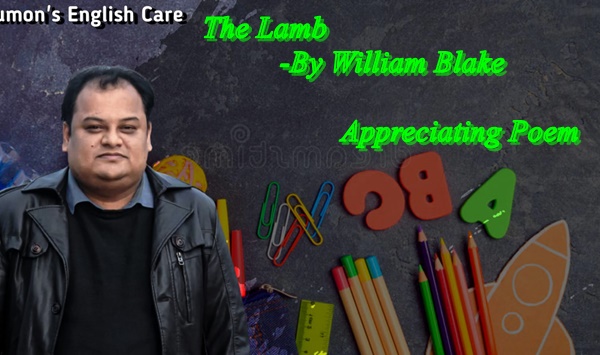The Lamb -By William Blake
The Lamb
-By William Blake
Little Lamb who made thee
Dost thou know who made thee
Gave thee life & bid thee feed.
By the stream & o’er the mead;
Gave thee clothing of delight,
Softest clothing wooly bright;
Gave thee such a tender voice,
Making all the vales rejoice!
Little Lamb who made thee
Dost thou know who made thee
Little Lamb I’ll tell thee,
Little Lamb I’ll tell thee!
He is called by thy name,
For he calls himself a Lamb:
He is meek & he is mild,
He became a little child:
I a child & thou a lamb,
We are called by his name.
Little Lamb God bless thee.
Little Lamb God bless thee.
Bengali Translation
ছোট মেষশাবক যে তোমাকে তৈরি করেছে
তুমি কি জানো কে তোমাকে বানিয়েছে
তোমাকে জীবন দিয়েছি এবং তোমাকে খাবার দিতে বলেছি।
স্রোত এবং ঘাস দ্বারা;
তোমাকে আনন্দের পোশাক দিয়েছি,
নরম পোশাক পশম উজ্জ্বল;
তোমাকে এমন কোমল কণ্ঠ দিয়েছি,
যা সব উপত্যকাকে আনন্দিত করেছে!
ছোট মেষশাবক যে তোমাকে তৈরি করেছে
তুমি কি জানো কে তোমাকে বানিয়েছে
ছোট্ট মেষশাবক আমি তোমাকে বলব,
লিটল ল্যাম্ব আমি তোমাকে বলব!
তাকে তোমার নামে ডাকা হয়,
কারণ সে নিজেকে মেষশাবক বলে:
তিনি নম্র এবং তিনি নম্র,
তিনি একটি ছোট শিশু হয়ে ওঠে:
আমি শিশু আর তুমি ভেড়ার বাচ্চা,
আমরা তার নামেই ডাকি।
ছোট মেষশাবক ঈশ্বর আপনার মঙ্গল করুন.
ছোট মেষশাবক ঈশ্বর আপনার মঙ্গল করুন.
(a)Answer the following questions:
i) Why is the poet asking the lamb question again and again?
ii) What qualities of the lamb does the poet appreciate?
iii) What is the main idea of the poem?
(b)How many stanzas are there in the poem?
(c) Write the rhyming words in the following table.
| Feed | —————- |
| Delight | —————- |
| ————— | Rejoice |
| ————— | Lamb |
| Mild | ————– |
| ———— | me |
(d) Write the summary of the poem.
Answer:
(a)
(i) The poet is really surprised to see the lovely little lamb. So, from his curiosity he wants to know its creator and asking the lamb question again and again.
(ii) The little lamb is so cute. It has soft and bright wool. It has tender voice that rejoices the whole valley. It is meek and mild.
(iii) The main idea of the poem is about a lovely lamb that is the beautiful creation of the creator.
(b) There are two (2) stanzas in the poem
(c)
| Feed | mead |
| Delight | bright |
| voice | Rejoice |
| name | Lamb |
| Mild | child |
| Thee | me |
(d) The poem is the words of a child asking a lamb if the lamb knows who created it. The child answers their own question, telling the lamb that it is the Lord Jesus Christ who created it. The lamb and Christ are described in similar terms, both as ‘meek’ and ‘mild’, for Christ is often referred to as the lamb of God.
Q1: What is the significance of the Title?
Answer: “The Lamb” by William Blake describes a speaker who identifies himself as a child and questions a lamb about its maker, source of food, delightful clothing and a pleasant voice. The poem is taken from the collection “Songs of Innocence” and it accurately represents one side of the theory of contrariness by Blake. The traditional image of Jesus as a lamb underscores the Christian values of gentleness, meekness and peace. Hence, the title is appropriate.
Q2: How does the poet interrogate the lamb? / Comment on the questions asked by the child.
Answer: In the poem “The Lamb”, the child speaker asks the lamb some naïve and yet profound questions like about its maker, source of food, delightful clothing and a pleasant voice. Though the questions are simply asked, they inquire about very grave knowledge’s like the origin and nature of creation. The child itself answers the questions and the answers seem easy which also contribute to an underlying sense of ironic knowingness in the poem. The questions and the answers obviously reveal simple Christian faith and the acceptance of its teachings.
Q3: Who is the speaker addressing in William Blake’s “The Lamb”?
Answer: There is no doubt in my mind that William Blake is addressing an actual lamb, but that he is drawing attention to God and his son Jesus, the Lamb of God.
Q4: What is the common theme in William Blake’s “The Tyger” and “The Lamb”?
Answer: The Tyger and the Lamb are poem from Blakes’s collection of poetry called “Songs of Innocence and Experience”.
Q5: How does Blake depict religion in this poem?
Answer: Blake is usually critical about religion in his poetry, but The Lamb is surprisingly positive. Overall, the poem seems to be a celebration of God’s beautiful creations in the world, including the lamb.

